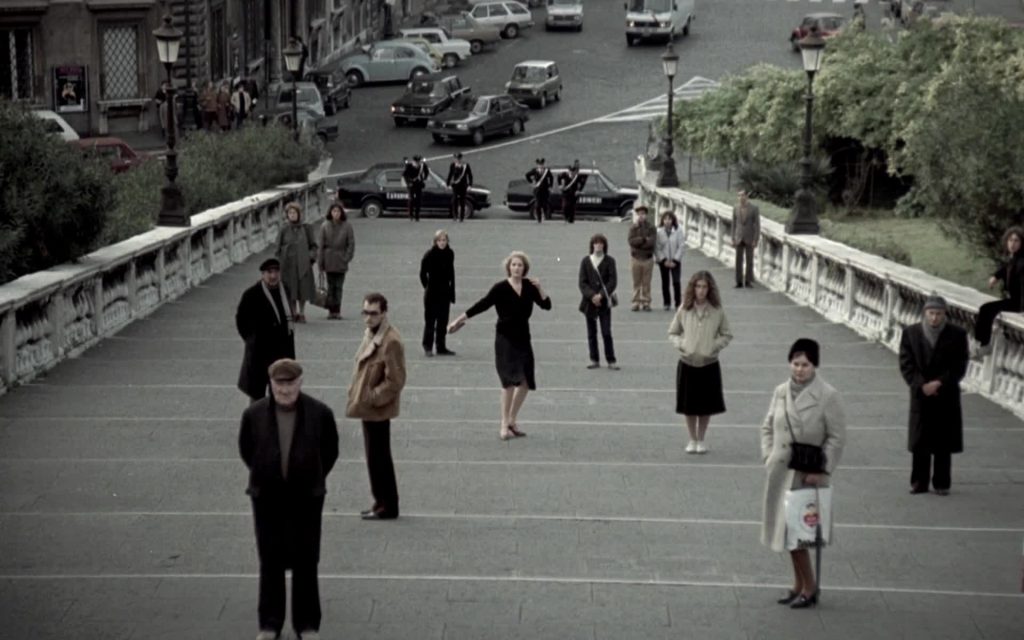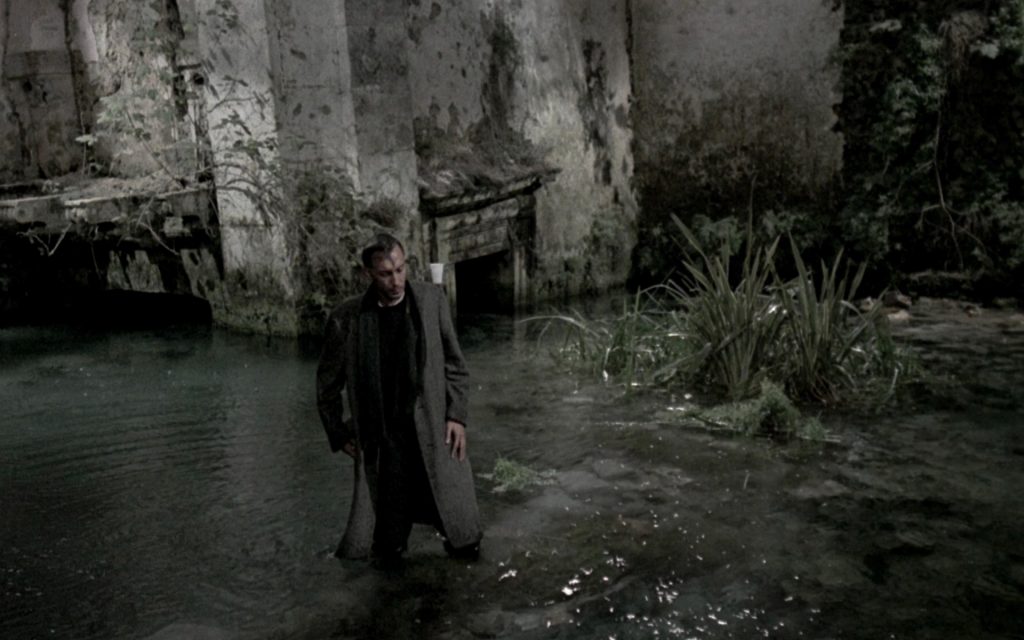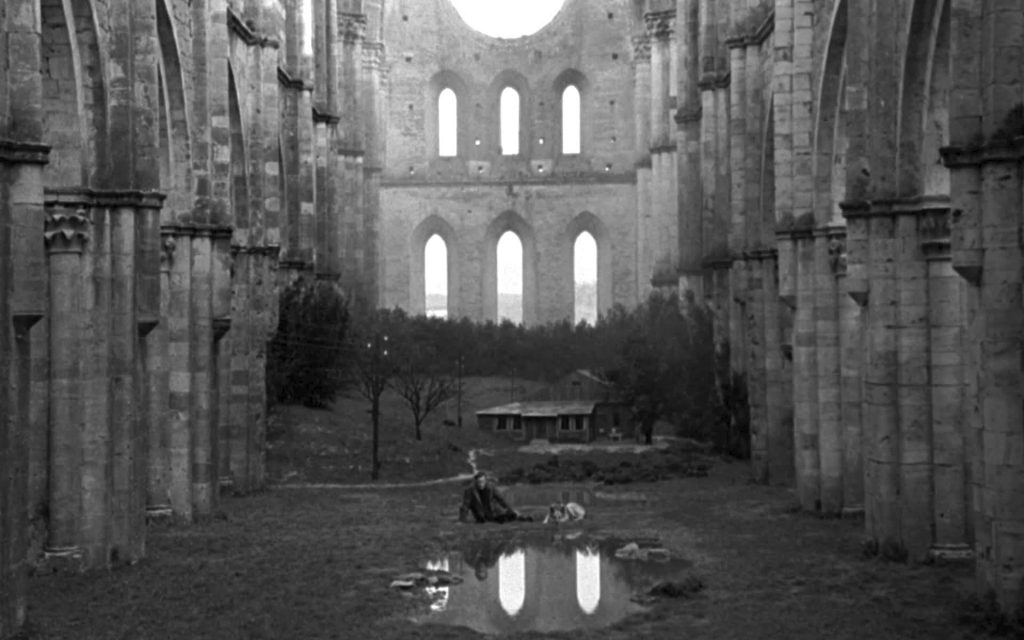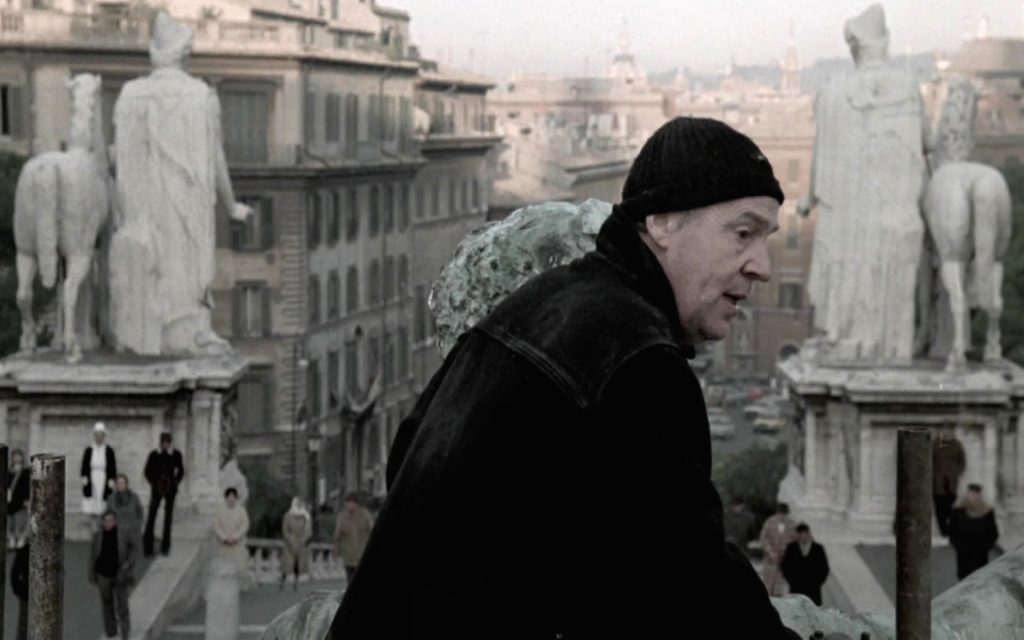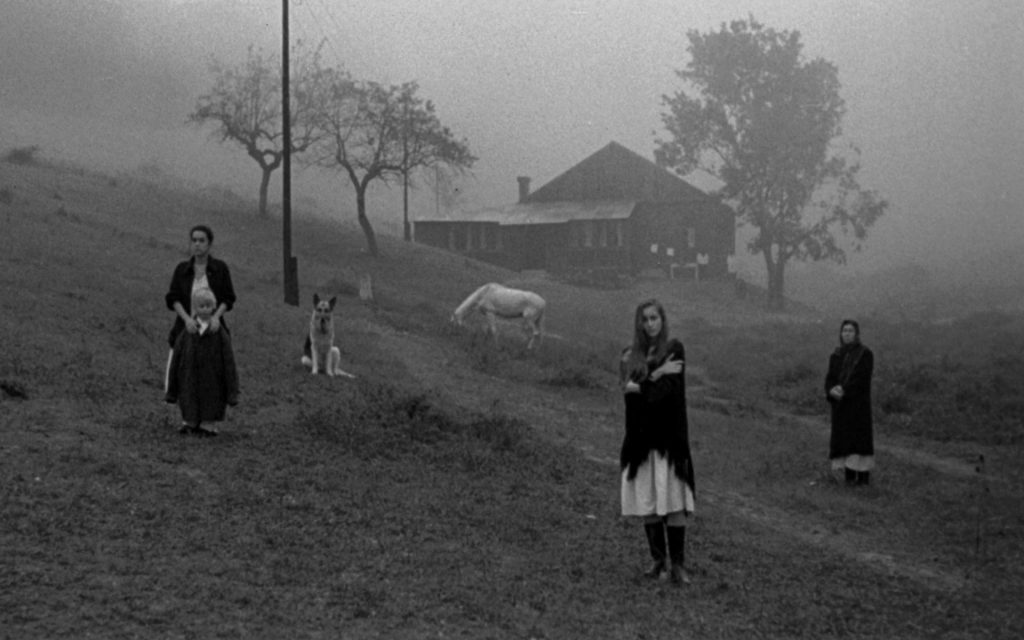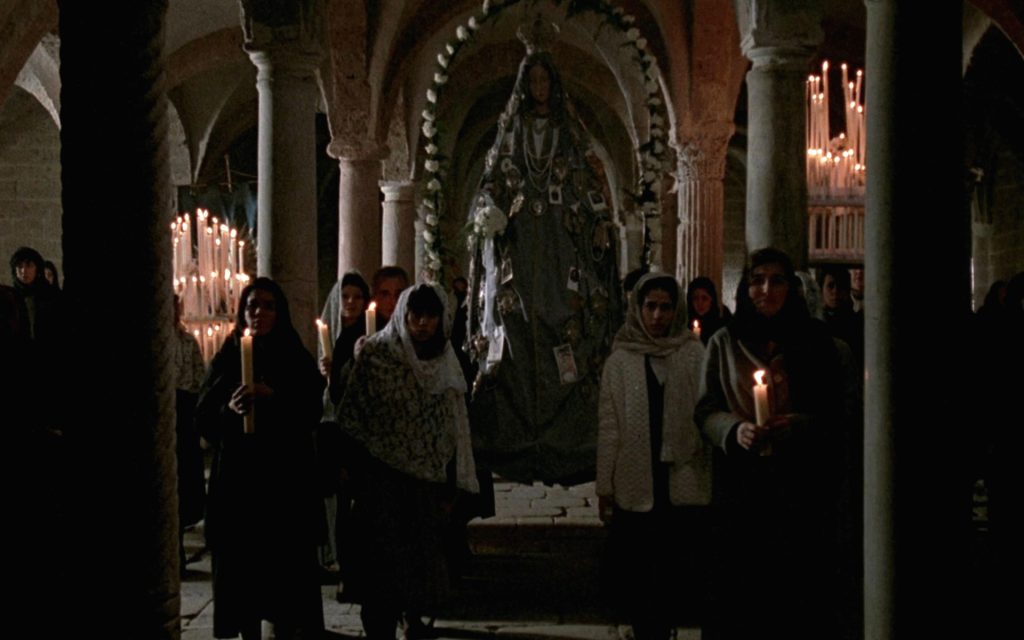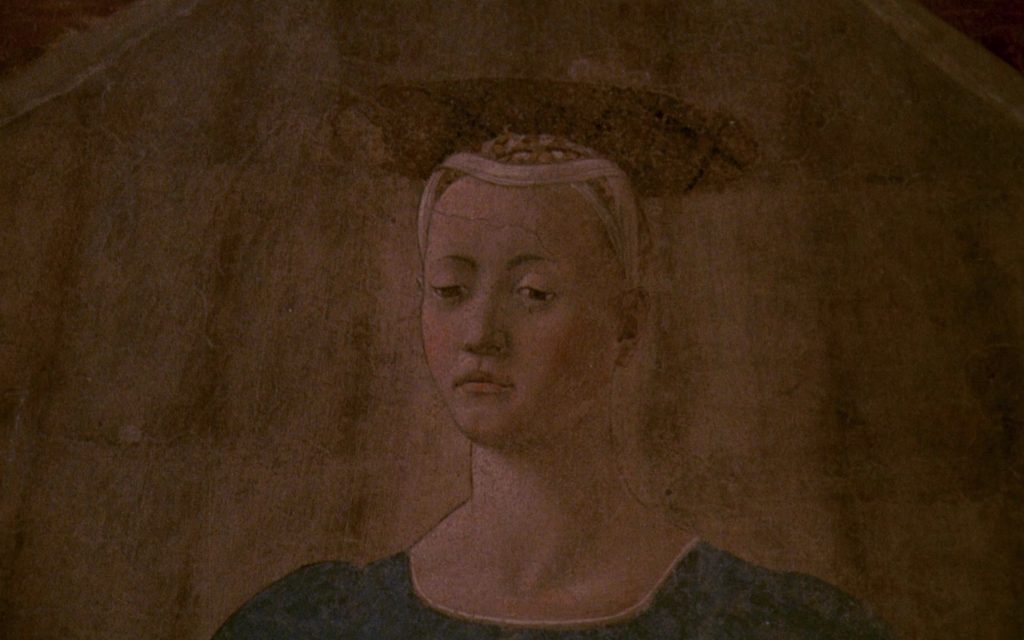Nostalghia (1983) was Andrei Tarkovsky’s sixth feature film, and the first feature he made abroad. Although he didn’t know it at the time, it marked the great Russian filmmaker’s permanent break with the Soviet Union. He would never go back, and he would make only one more film, The Sacrifice, before dying of cancer, in exile, in late-December 1986, at the age of 54. (Nota bene: Although Nostalghia was his first feature on foreign soil, he and co-screenwriter Tinino Guerra had preceded it in 1982 with another Italian-made film, an interesting and thematically related travel documentary for Italian television called Tempo di Viaggio.)
If Nostalghia represents a major break in the above sense—and represented too Tarkovsky’s own disrupted, transplanted state of mind at the time—it was above all, however, a continuation and culmination of an artistic vision whose depth, originality and cohesion have few parallels in the history of cinema.
Already with Andrei Rublev, his 1966 masterpiece, Tarkovsky had flagged the moral function of art as a major concern. Even there, and in subsequent films, especially The Mirror (1975), he incorporated elements of his own biography in his philosophical and moral musings on time, place, memory, faith and personal as well as social redemption. As early as Solaris (1970), the interplay of conscience and civilization’s detachment from spiritual values took place against a backdrop of ecological imbalance. By the time of Stalker (1979), the work that immediately precedes Nostalghia, this imbalance had become outright catastrophe—an aspect that gave Stalker prophetic overtones in the aftermath of Chernobyl (or today, on the third anniversary of Fukushima, among other dire environmental calamities).
In tandem with these thematic concerns, Tarkovsky crafted a cinematic language that would not merely express them but would be the primary, non-narrative vehicle of their development. Nostalghia represents a further advance in Tarkovsky’s concept of cinema—a concept very much distinct (and antithetical) to the widely influential ideas of Sergei Eisenstein, who prized the cut and the juxtaposition of images as the essence of film language. For Tarkovsky, cinema at its purest was a form of sculpting in time (a phrase he used for the title of his book on the subject). What mattered, therefore, was allowing the viewer the opportunity to share in the flow of time. The director became highly adept at the long take, exploring carefully constructed mise-en-scène through exquisitely controlled camera movement. At the same time, Tarkovsky deliberately blurred the lines between inner and outer worlds—between the psychological or spiritual realm of his characters and the material “reality” around them. Nostalghia’s startling use of lighting, for example—its shape-shifting undulations of light and shadow within single scenes—is a key strategy for expressing, and dynamically joining, these realms. As a stylistic strategy, it advances techniques seen in Stalker and used to consummate effect in his last film, The Sacrifice (1986).
Both in theme and stylistic invention, then, Tarkovsky’s sixth film builds on what came before and clears the way for what lay ahead. It also remains a magnificent film on its own, characterized by a languid, moody and thrilling beauty as well as a compelling moral urgency that feels undiminished, indeed reinforced by the intervening decades.
That does not mean Nostalghia is an easy film, or without faults. (Its initial critical reception in the U.S. was mostly dismissive if not scornful, as it was for his work in general.) Like all his major films, Nostalghia is thoroughly anti-commercial and departs decisively from the usual narrative conventions. Its strategies can feel varyingly successful as well. As with all of Tarkovsky’s work, Nostalghia bears, and almost demands, repeated viewings in order to fully glean its rich detail—much of it tied to a set motifs across all his films, which have a cumulative order and a self-referential quality of their own.
Nevertheless, the impression Nostalghia makes on a first viewing is immediate, its lush visuals and dreamy, melancholic atmosphere evoking precisely a world unto itself that is also, paradoxically, a re-introduction to our own. Moreover, for contemporary audiences reared on Kubrick’s 2001: A Space Odyssey, the films of Michael Haneke, or Wong Kar-wai, for example, it can be a joy, and hardly a forbidding task, to enter Nostalghia’s unrushed sculpting—its purposefully ambiguous dreamscapes; masterfully long takes and majestic tracking shots; elliptical, pensive narratives; oblique relationships, and often stern characters. They require a different kind of viewing than a Hollywood movie, naturally, but just about any cinephile or adventurous newbie can attune readily to the film’s pace and logic, and derive great rewards for the effort.
Inner and Outer Worlds
Nostalghia concerns a homesick Russian poet, tellingly named Andrei (played by a brooding, inward, yet charismatic Oleg Yankovsky), who leaves wife and family to come to Italy and research the biography of an 18th-century Russian composer named Sosnovsky (based on the real-life composer Maksim Beryózovsky). Sosnovsky was a serf, we learn, whose talent was such that his master allowed him to travel abroad, but his longing for Russia brought him back to servitude, and eventually he took his own life. (The loose parallel between the filmmaker and his protagonist is thus doubled in a paralleling between the protagonist and his own subject.) Andrei, terribly homesick and distracted himself, makes unenthusiastic visits to two historic sites with the help of his interpreter, the beautiful and smitten Eugenia (played by a vital Domiziana Giordano). While visiting the second site, Saint Catherine’s baths, Andrei hears about a local eccentric who locked up his family for seven years awaiting the apocalypse. Andrei suddenly appears interested, and asks to meet him. It is clearly the man’s faith that attracts Andrei’s curiosity.
“I don’t understand ‘faith.’ What is it?” he asks Eugenia, meaning the question literally. After she translates the word into Russian, he says of Domenico, “Why do they say he’s mad? He’s not mad. He has faith.” She notes that there are many such “lunatics” around Italy since the asylums closed, as their families refuse to take them in. “We don’t know what madness is,” says Andrei. “They’re troublesome, inconvenient. We refuse to understand them. They’re alone. But they’re certainly closer to the truth.”
Indeed, the man in question, Domenico (played by Ingmar Bergman stalwart Erland Josephson, who is equally brilliant in the somewhat related role of Alexander in The Sacrifice), is a kind of holy fool. He asks Andrei to carry out a task that he has been prevented from accomplishing himself: carrying a lighted candle across the baths. Later, Eugenia, who finally leaves Andrei in frustration at his lack of interest in her, calls him from Rome from whence Andrei is about to fly home. She tells him Domenico is in the city, and he is asking if Andrei has fulfilled what he asked of him. Andrei, tired and suffering from a heart condition, nevertheless delays his flight to return to the baths, where he painstakingly attempts three times to cross them with the lighted candle. At the same time, Domenico delivers a sermon to a strangely artificial-looking crowd from atop a large statue, which culminates in a desperate act. Their destinies entwined, each achieves a deeply ambiguous goal out of all normal, rational calculation.
Nostalghia’s minimal plot, while important, is subordinate to the film’s visual language, which conveys powerfully a set of ruminations on faith, memory and desire in an automatonic civilization running blindly toward destruction. A few primary details early on set the tone and the terms for these concerns.
The opening title sequence, in black and white—the film tacks between black-and-white and color throughout, the former sequences seemingly tied to the worlds of memory and dreams, although this becomes less strict or certain a delineation as the story proceeds—appears over a misty bucolic scene that slopes down and away from the camera, inhabited by a family who also walk away from us, toward a river in the distance, a dog (a German shepherd who appears throughout) accompanies them, and a horse stands in the distance. The next scene is in color but of a very subdued quality, distinct from the previous scene yet perhaps not so far away from it either. A car rolls up with a man and woman inside. Again, we’re in the countryside; again there is a mist rolling through it (mists, clouds, rain and dripping water pervade the film, as throughout Tarkovsky’s work). From their few words together we gather we are in Italy, presumably in the present. They have driven a long way to look at an ancient site. The man (Andrei) decides he’s had enough of these “beauties” and will not go inside. He and the woman (Eugenia) emerge from the car and head off separately up a narrow path.
Inside the church, Eugenia approaches the famous painting on the wall, Piero della Francesca’s Madonna del Parto (Madonna of Childbirth), before which a bank of votive candles glows brightly. She barely has time to consider it before a man, the sacristan, asks her if she wants a baby too, or is asking God to spare her. She answers that she’s just looking. The man, whose dramatic face now appears in the foreground turning to the camera, answers that the presence of mere onlookers (non-supplicants, nonbelievers) tends to mean nothing happens. “What is supposed to happen?” asks Eugenia. “Whatever you like,” he answers. “Whatever you need most. But you should at least kneel down.”
Thus, in its opening moments, Tarkovsky opens the philosophical and moral ground of the film—or reopens it, since the question of faith, the tortured mingling of material and spiritual realms, is central to his oeuvre. Indeed, it is almost as if we were back in the Zone, in the mystical, wish-granting Room of Stalker. Here, however, the “foreignness” and the crumbling grandeur of Italy, at once ancient and modern, provide a particular lens of their own.
Eugenia at first starts to kneel but changes her mind, visibly uncomfortable with the idea. Her proud and beautiful figure looks a little ridiculous in the aborted attempt. She is a woman thoroughly associated here with the modern age.
Meanwhile, Andrei’s lack of interest in the Francesca painting (he never bothers to go inside and look at it) sounds the central note of his character, one already flagged by the title: He cannot enjoy or engage with his surroundings, remaining tied to an unyielding yearning for the past and for home. His condition is one of profound alienation, which the actor Yanoksvky plays with a fine combination of superiority and helplessness.
The final scene in the church shows Eugenia staring into the portrait of the Madonna of Childbirth as if in a mirror (mirrors and paintings both being evocative objects across Tarkovsky’s body of work), but also as if at an impossible distance, some perfect outer limit defined by art and, simultaneously, the motherhood the character will never know.
From here the film cuts to a close up, in black and white, of Andrei’s face, a striking shot and our first real image of him. As Andrei turns his head we see too the odd streak of grey in his hair (reminiscent of that in the similarly melancholic protagonist of Solaris, or the pattern in the title character from Stalker). A feather, almost the same shape and color of this streak, floats by and down to the ground. We see Andrei looking over to a dacha in the distance (the family home, which will return in later scenes), a just barely perceptible white figure with what appear to be wings crosses before it.
Through a startling set of images like these in its opening sequences, the film develops its frankly religious and philosophical themes. Cinematographer Giuseppe Lanci (rightly famed for his work with director Marco Bellocchio) paints a superb double world throughout, in light and motion that draw forth often simultaneously the psychical and physical realities of the main character.
The Russian concept of “nostalgia,” as Tarkovsky himself stressed, is a distinctive blend of feelings of love and loss, a melancholic association with that from which one is separated. References by Andrei to the untranslatable nature of poetry (significantly, Tarkovsky references here his own poet-father, Arseny Tarkovsky) and the corresponding need to eliminate all borders between countries mark out a kind of despair and idealism at once. Such feelings resonate as a crisis of faith, with overtly social overtones, as Andrei’s alienation—as well as the inspiration awakened in him by Domenico—takes place against a materialistic civilization dangerously divorced from nature by a narrow, instrumental rationalism.
If Nostalghia’s focus on redemption and spiritual transcendence tends to cast the artist in the lofty part of seer and even savior, Tarkovsky’s genius gives us grounds for at least entertaining the idea. Ultimately, human beings will no doubt deliver themselves or be lost, but the role of the artist as a guide and spur to consciousness and conscience is no luxury but a necessity, and even a prerequisite of art. As Tarkovsky put it in Donatella Baglivo’s 1984 documentary portrait, A Poet in Cinema, “The artist exists because the world is not perfect.” In this crisis-ridden age, there remain few filmmakers who redeem the art of cinema as a moral force with the persistent invention and resolute vision of Andrei Tarkovsky.


